Type the name of the breed you're looking for below
[wpdreams_ajaxsearchlite] Don't see the breed your're looking for? Click here and let us know!
Murray Grey cattle
| Place of Origin | Australia |
| Origin | The Murray Grey breed was developed from an initial chance mating of a black Aberdeen Angus bull and a roan Shorthorn cow in 1905 during the Federation drought. The resulting thirteen dun-grey calves from these matings were kept as curiosities and then bred on the Thologolong property along the Murray River in New South Wales by Peter and Ena Sutherland. These unusually coloured cattle grew quickly, were good converters of feed and produced quality carcases. Local cattlemen soon became interested in the greys and began breeding them. The first larger-scale commercial herds were established in the 1940s. In the 1960s several grey cattle breeders were selling them as a commercial enterprise and the Murray Grey Beef Cattle Society was formed to register the cattle and to administer the breed. There are Murray Grey registries in Canada, New Zealand, the United Kingdom, and the United States. In New Zealand Murray Greys have been favoured because of their resistance to Facial eczema which is a problem in other cattle breeds. In 1963 negotiations were made to have the similar Tasmanian Grey beef cattle accepted into the Murray Grey Beef Cattle Society, but it was not until 1981 that the two organizations combined. Greyman cattle were developed in Queensland in the 1970s, specifically to suit the Queensland environment, by combining Murray Grey and Brahman breeds. Cattle breeders in the northern and western regions of Australia are increasingly using Murray Grey genetics to cross with Bos Indicus cattle to improve fertility, docility and carcase quality. Murray Greys are the third largest breed in Australia and because of their superior marbling and carcase traits, are in strong demand for meat exports to Asian countries. The Murray Grey Beef Cattle Society performance records the herd using the internationally recognized Breedplan for monitoring growth, milk and carcase quality. On 11 January 2011 a Murray Grey cow was swept 95 kilometres by flood waters that raced through a property owned by Veronica Nutley, at Patrick Estate, near Lowood in the Brisbane Valley. The cow was found alive, three days later, in Moreton Bay and was towed through mangroves to shore. She was identified by her National Livestock Identification System (NLIS) ear tag and returned to her owner. |
| Purpose | Beef cattle |
| Appearance | Hair colour ranges from very light silver to chocolate or dark grey; a few animals are even black but the majority are silver to a silvery-dun color. This colouring is very dominant, so when crossed with another breed, the colour is grey or silver (light grey). Their skin has a dark pigmentation, which helps prevent cancer eye (ocular squamous cell carcinoma), photosensitivity reactions and sunburned udders. They have performed well in snow country and in a trial which was undertaken at a commercial feedlot between December 2002 and June 2003 to determine the effect of high heat load on performance and carcase characteristics when fed a high energy diet for 165-183 days. In this heat stress trial they out performed the other trialled breeds by producing the highest average daily weight gains over this period. Their superior performance in this trial was attributed to their lighter coloured coats. |
| Horns | Murray Greys are naturally polled, which is a dominant characteristic that is passed on to their progeny. |
| Cows Average Weight | 500 - 700 kg (1,100 - 1,500 lbs) |
| Bulls Average Weight | 816 - 1043 kg (1,800 - 2,300 lbs.) |
| Other Considerations | Murray Grey cattle, embryos and semen have been exported to Canada, New Zealand, South America, the United Kingdom and United States. Murray Grey cattle have also been accepted into the South African Registrar of Livestock Improvement’s books. In Paraguay Murray Grey cattle have been used in crossbreeding programs involving Zebu and Charolais cattle. The Zebu and Charolais cattle there lacked the dark skins and early maturing traits of the Murray Greys. This crossbreeding program improved the fertility, calving ease and weight gains of the progeny produced there. |



